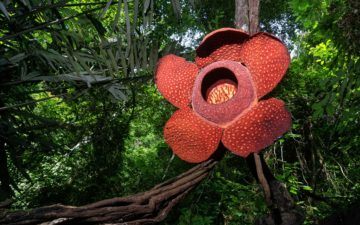Christie Wilcox in Quanta:
 They are invisible at first. In their Southeast Asian forest homes, they grow as thin strands of cells, foreign fibers sometimes more than 10 meters long that weave through the vital tissues of their vine hosts, siphoning nourishment from them. Even under a microscope, the single-file lines of cells are nearly indistinguishable from the vine’s own. They seem more like a fungus than a plant.
They are invisible at first. In their Southeast Asian forest homes, they grow as thin strands of cells, foreign fibers sometimes more than 10 meters long that weave through the vital tissues of their vine hosts, siphoning nourishment from them. Even under a microscope, the single-file lines of cells are nearly indistinguishable from the vine’s own. They seem more like a fungus than a plant.
But when the drive to breed awakens them, the members of the Rafflesiaceae family erupt as immense, stemless, rubbery red “corpse flowers” covered in polka dots, with a putrid smell like rotting meat designed to draw pollinating carrion flies. The blooms of one species, Rafflesia arnoldii, are the largest flowers in the world — each one can be more than a meter across and weigh a whopping 10 kilograms, roughly the heft of a toddler.
More than a decade ago, Rafflesiaceae parasites caught the eye of Jeanmaire Molina, an evolutionary plant biologist at Long Island University in Brooklyn, who wondered if their genomes were as bizarre as their outward forms.
More here.
